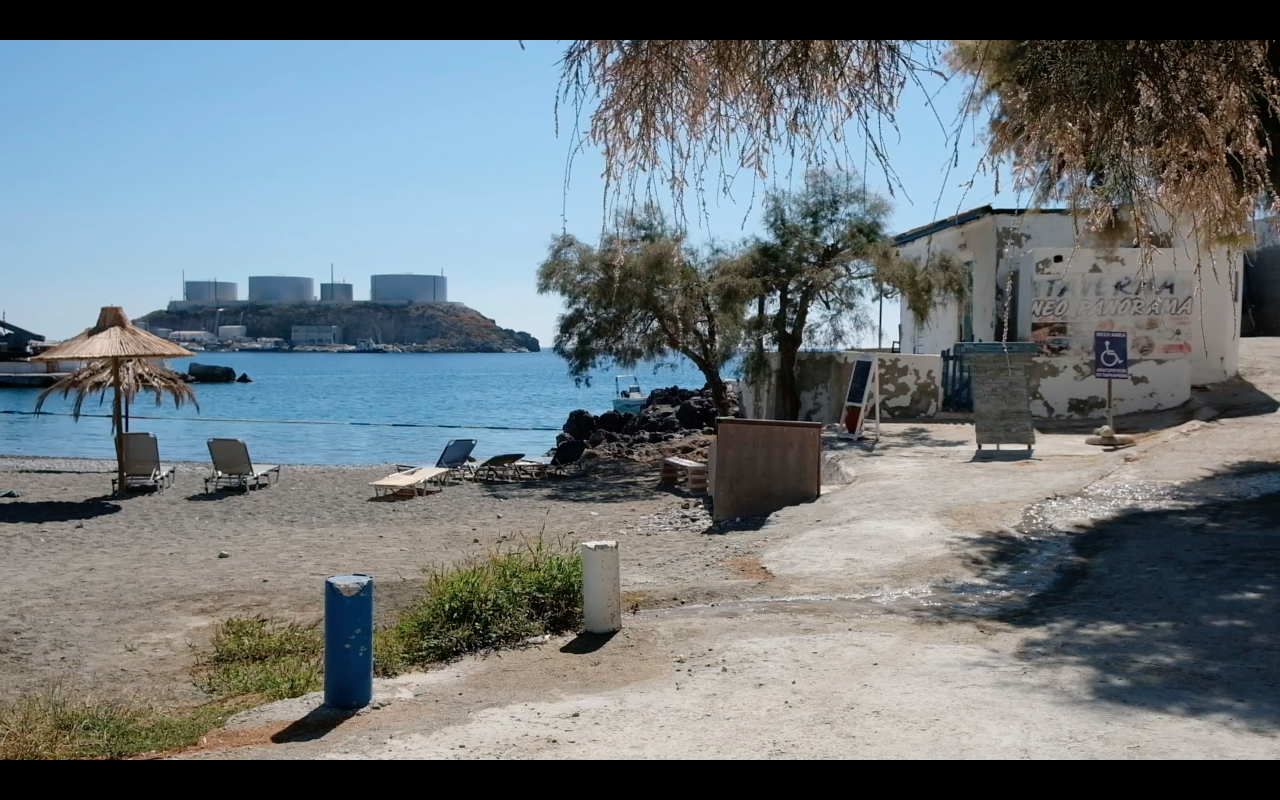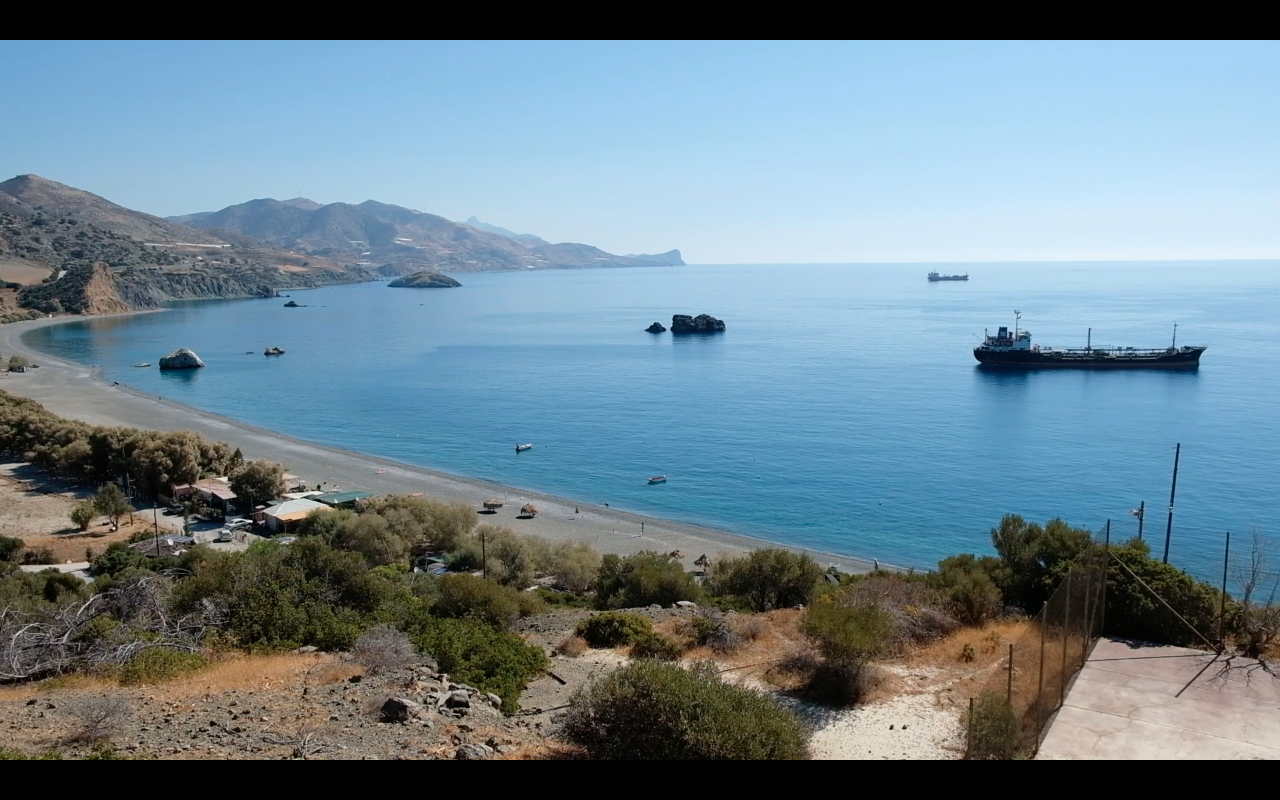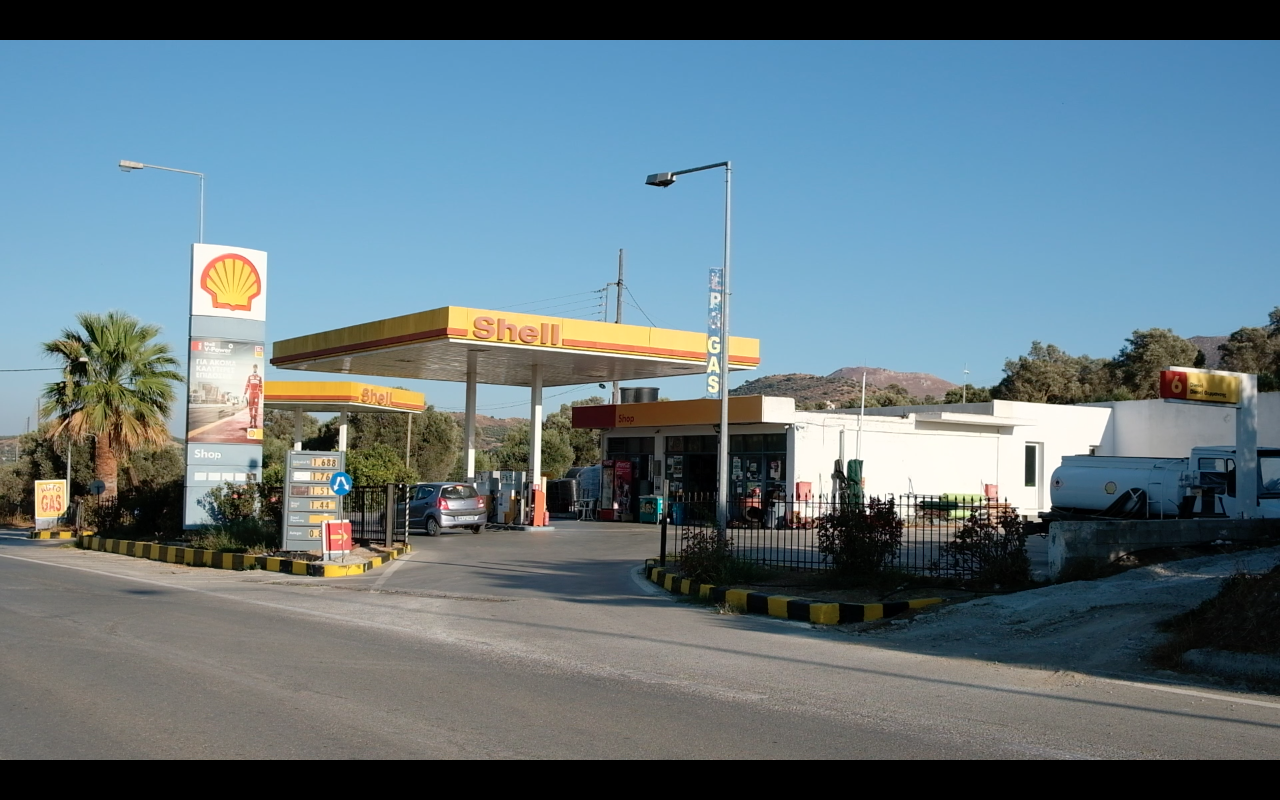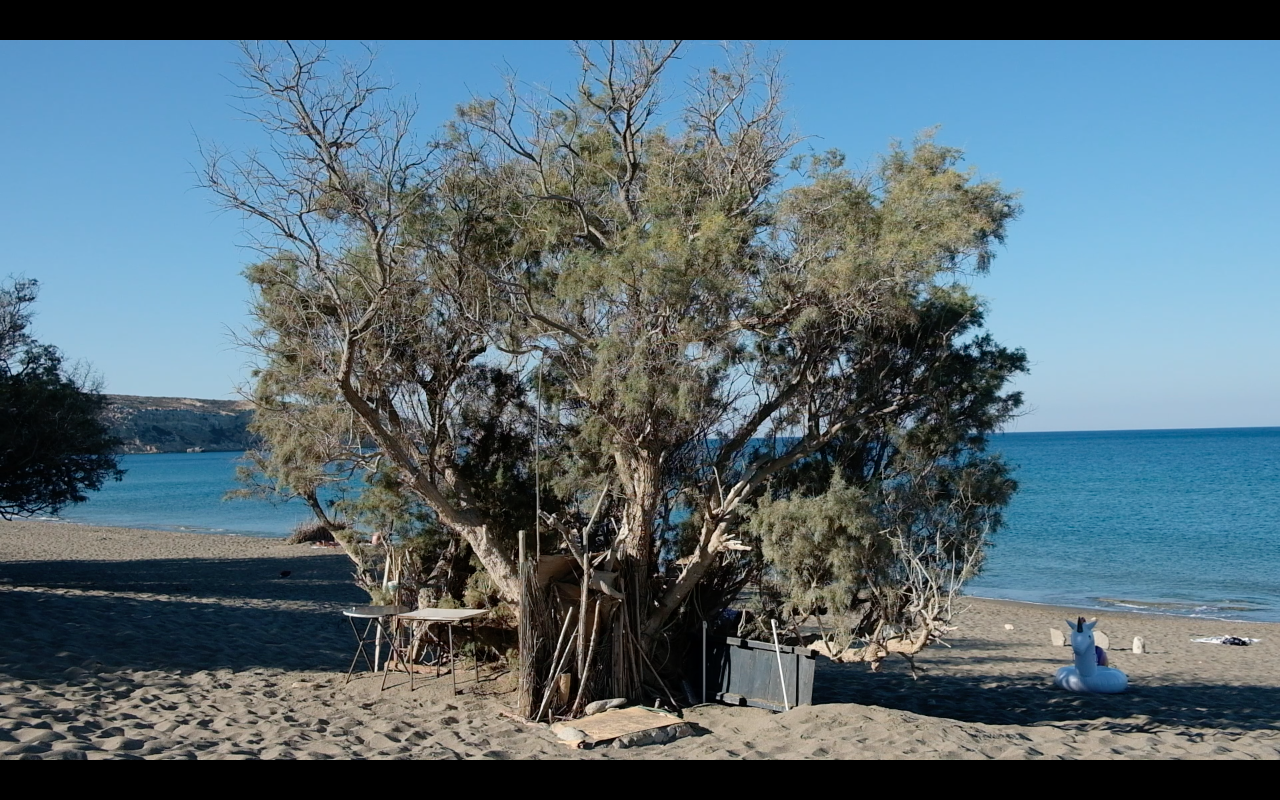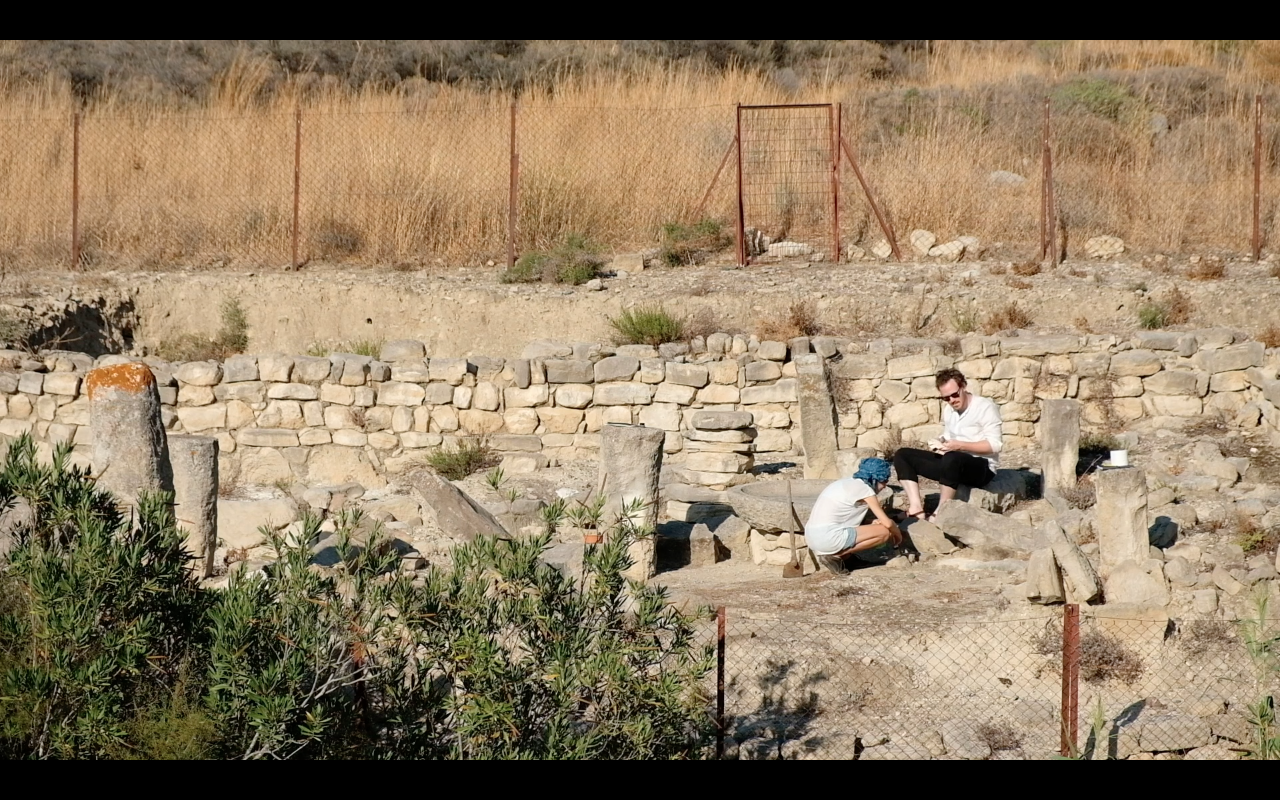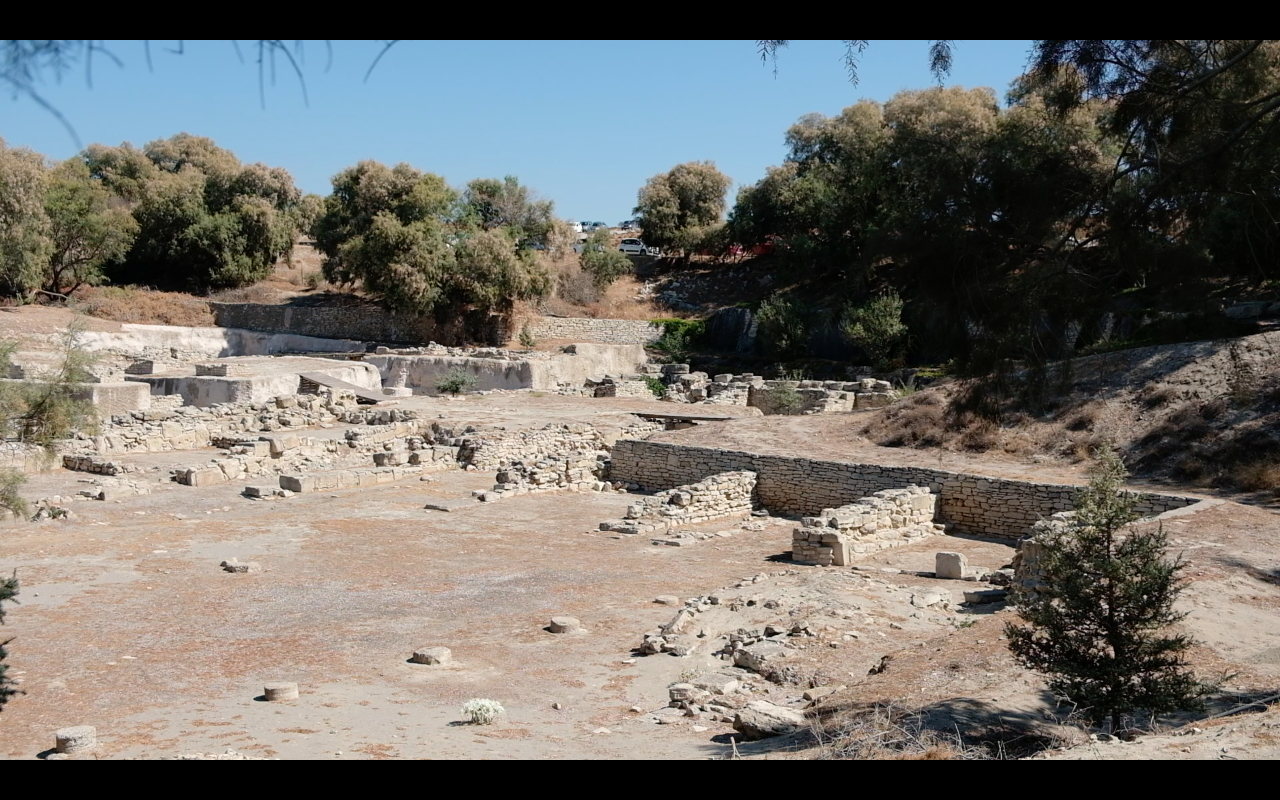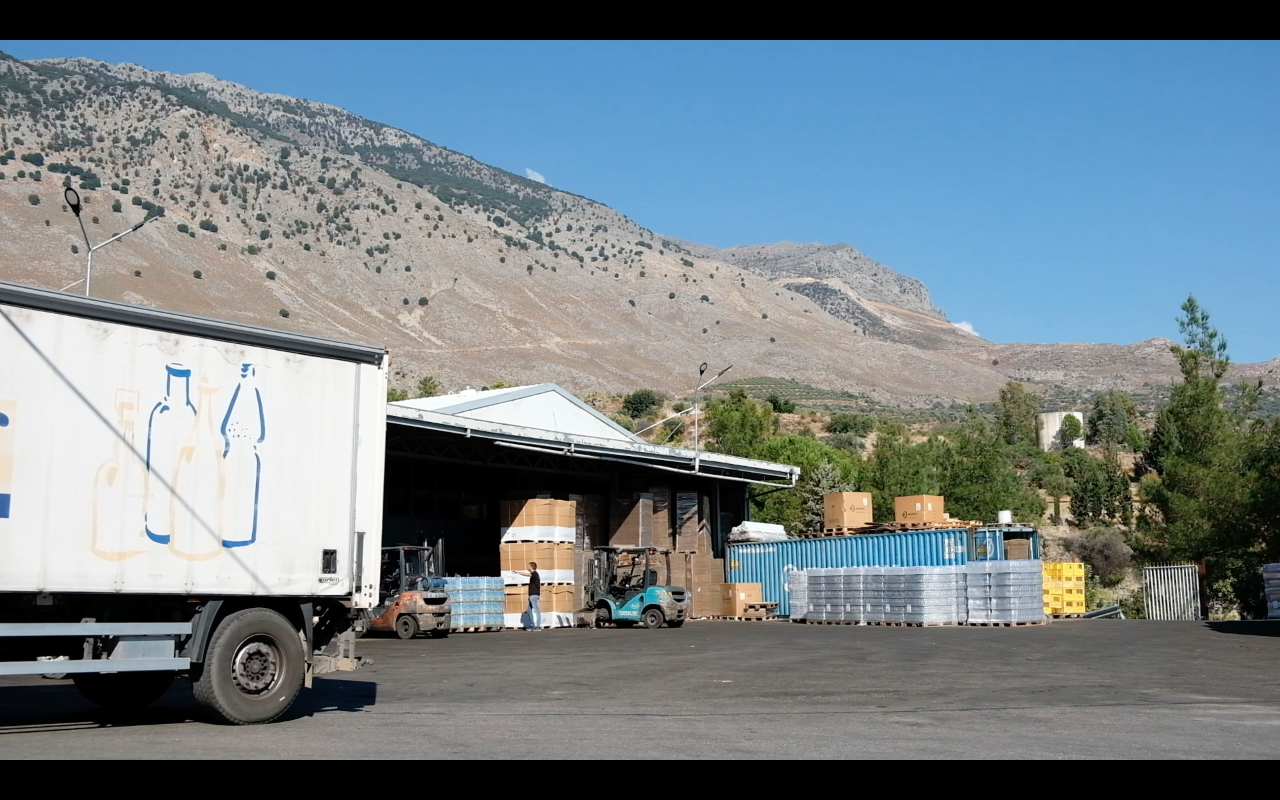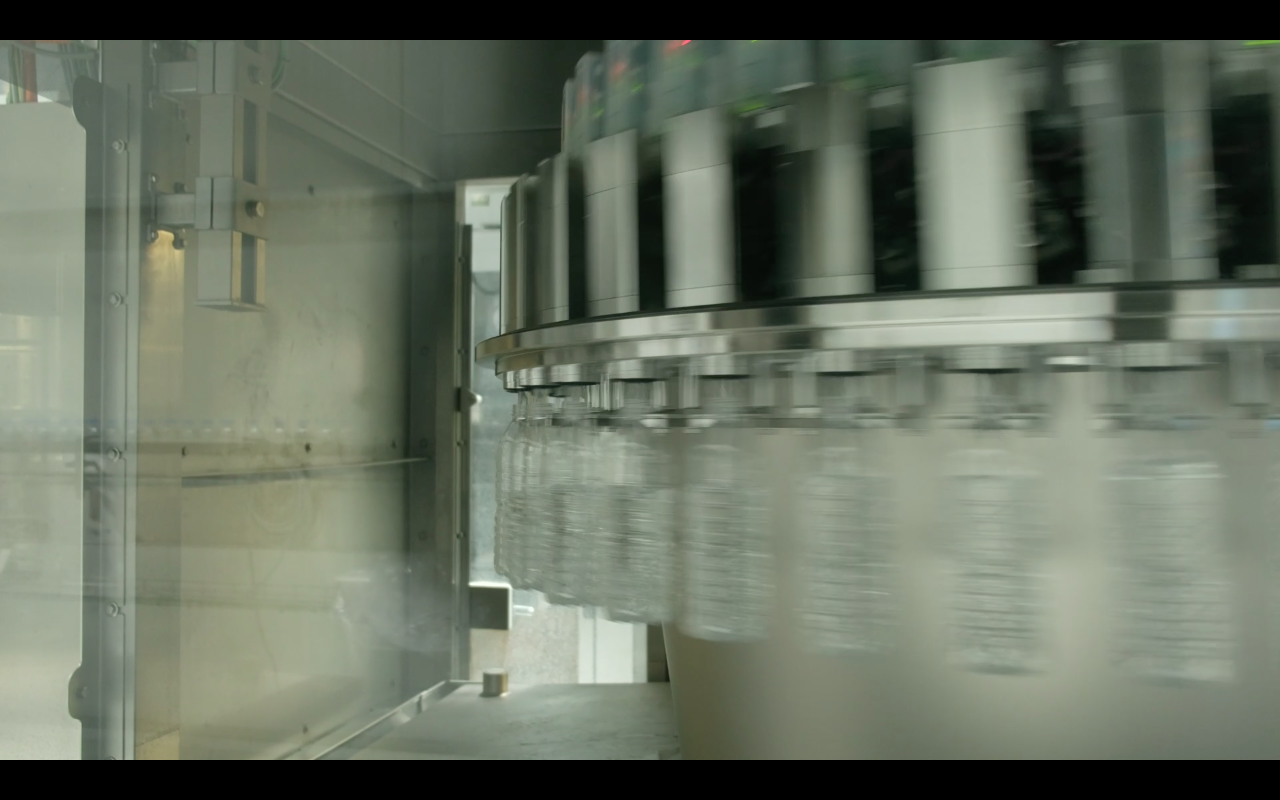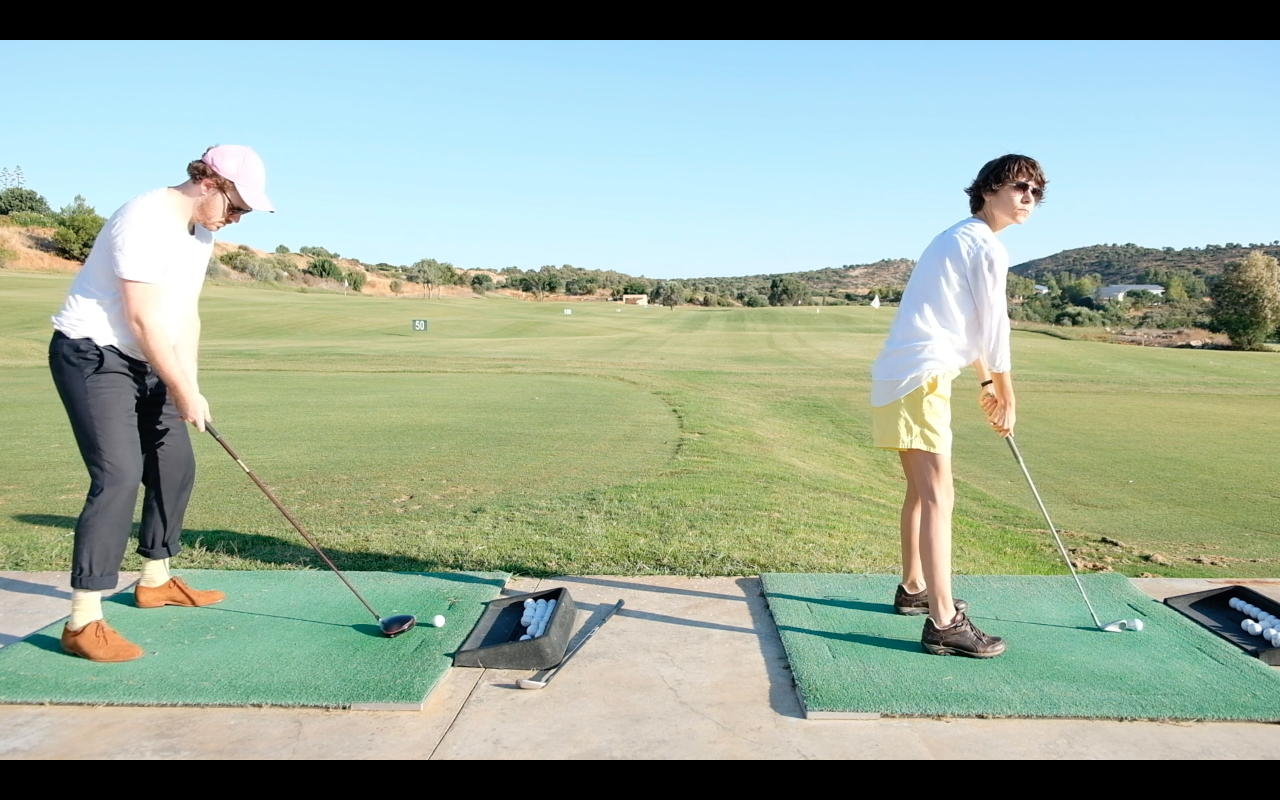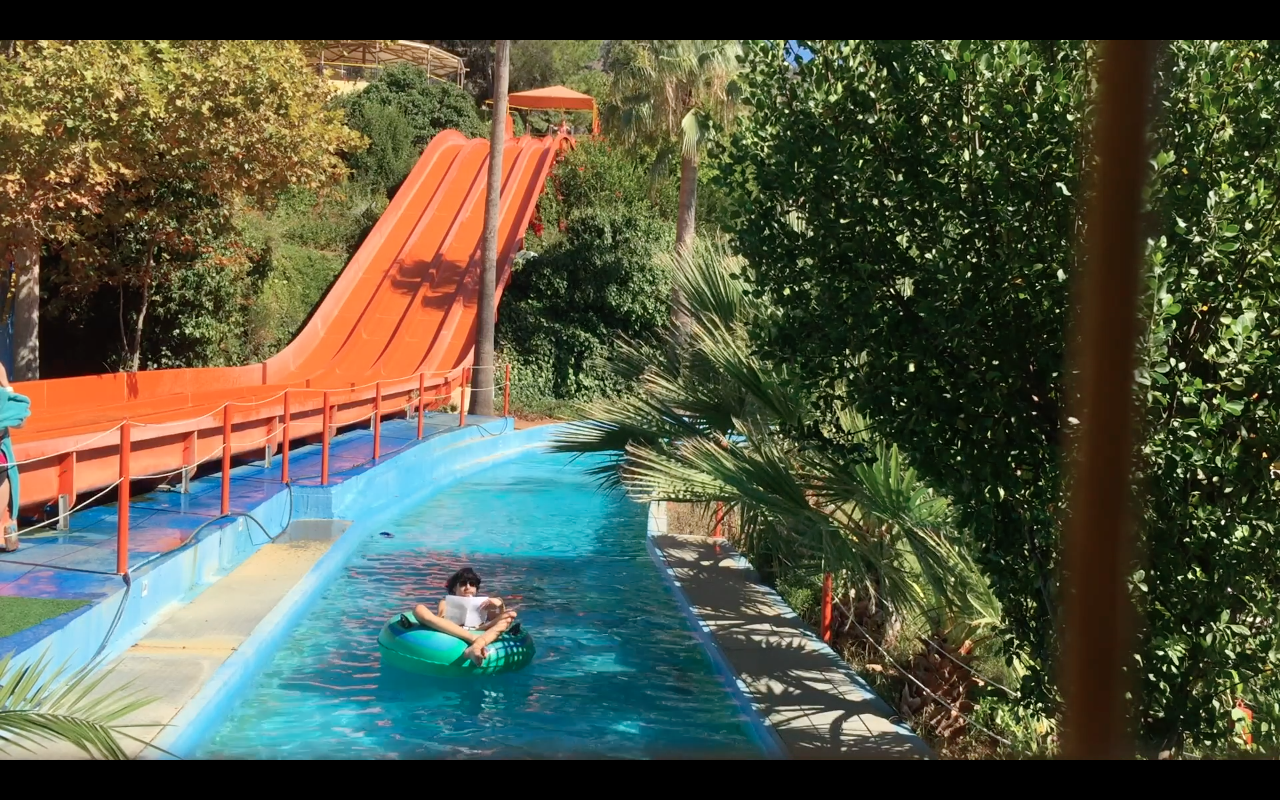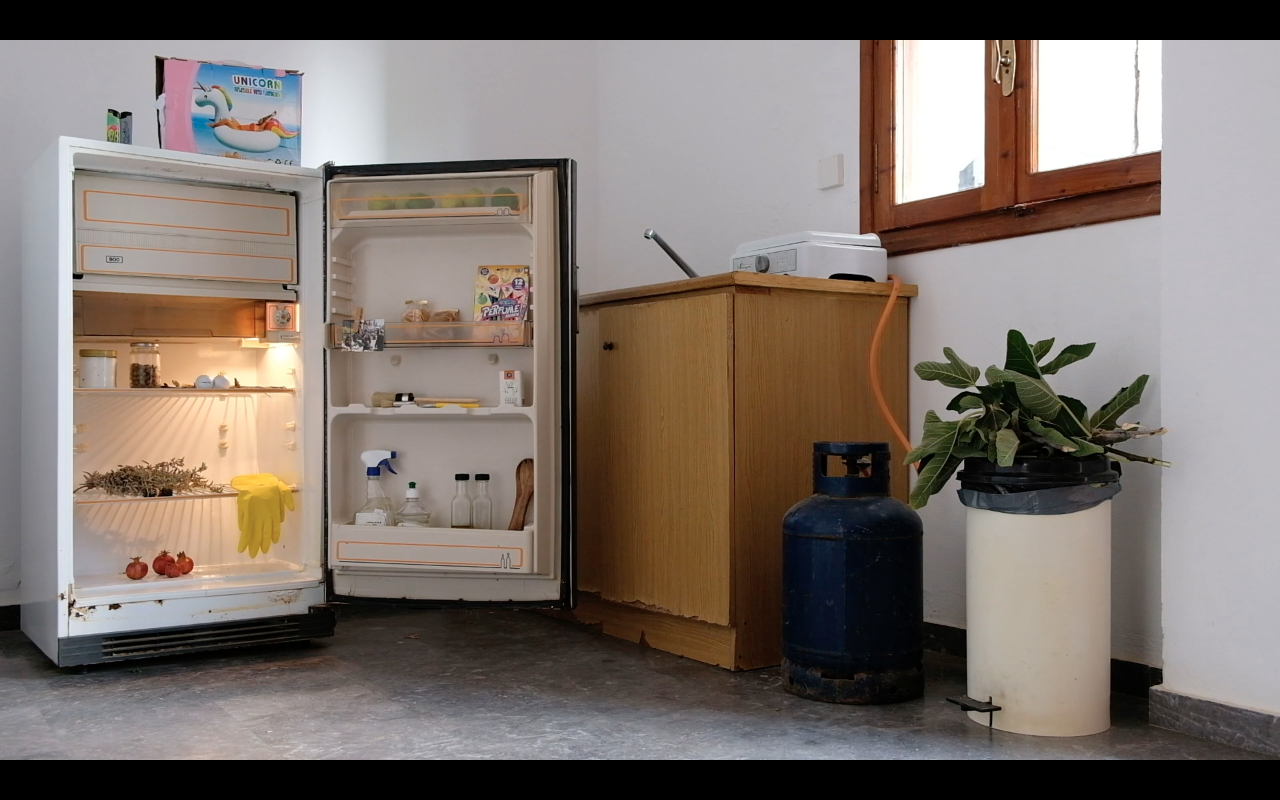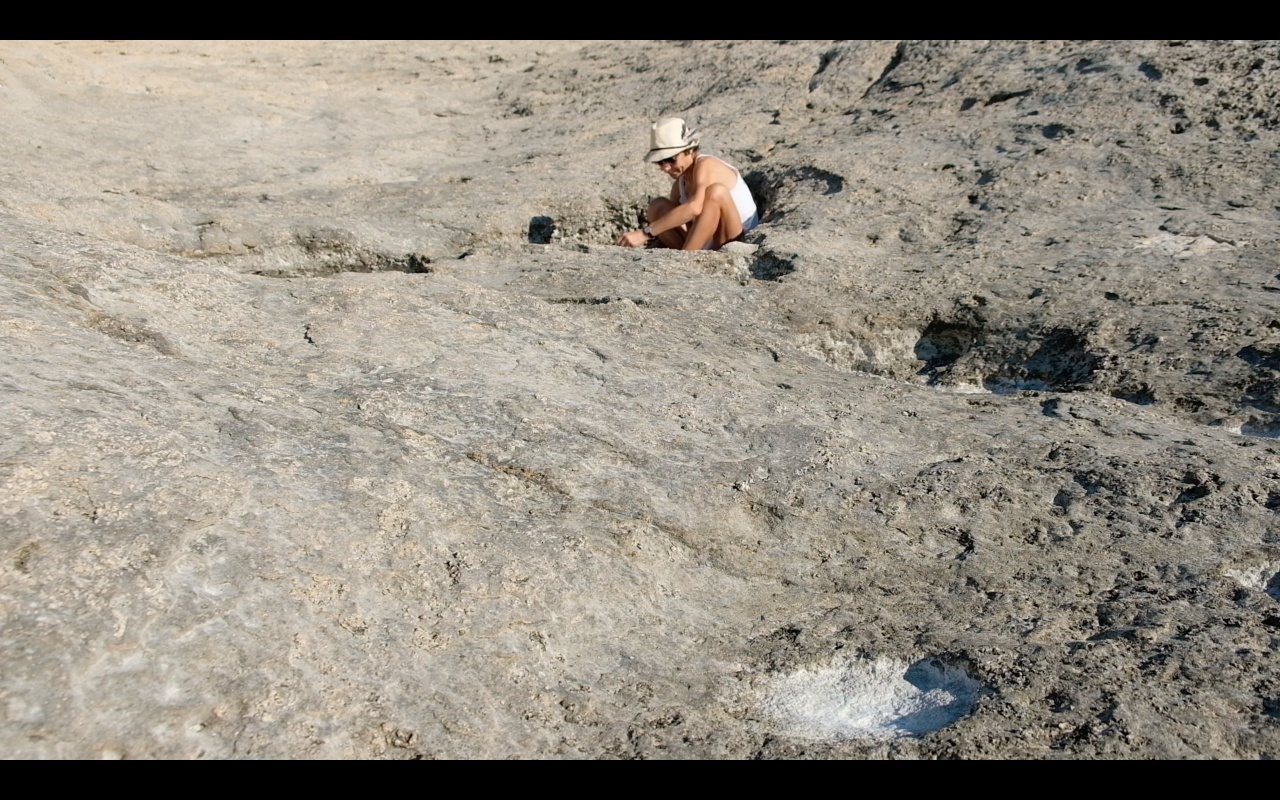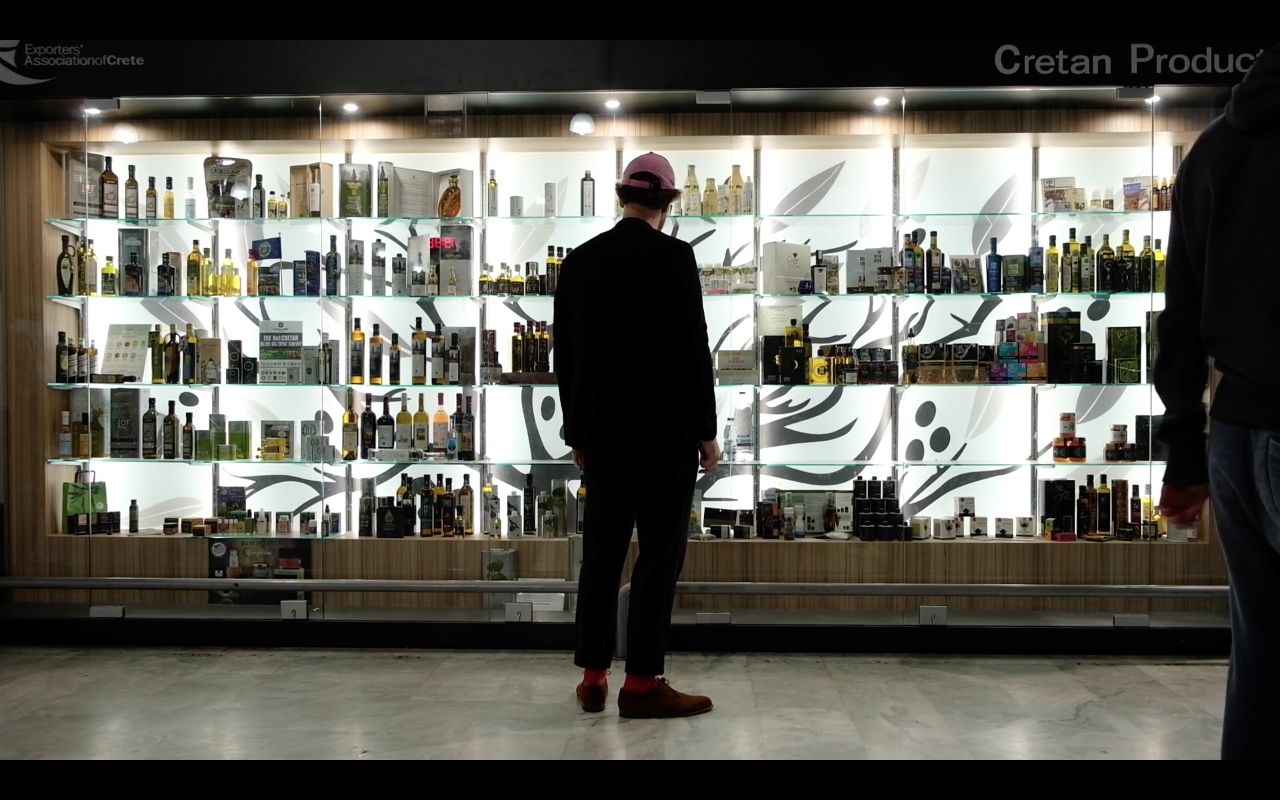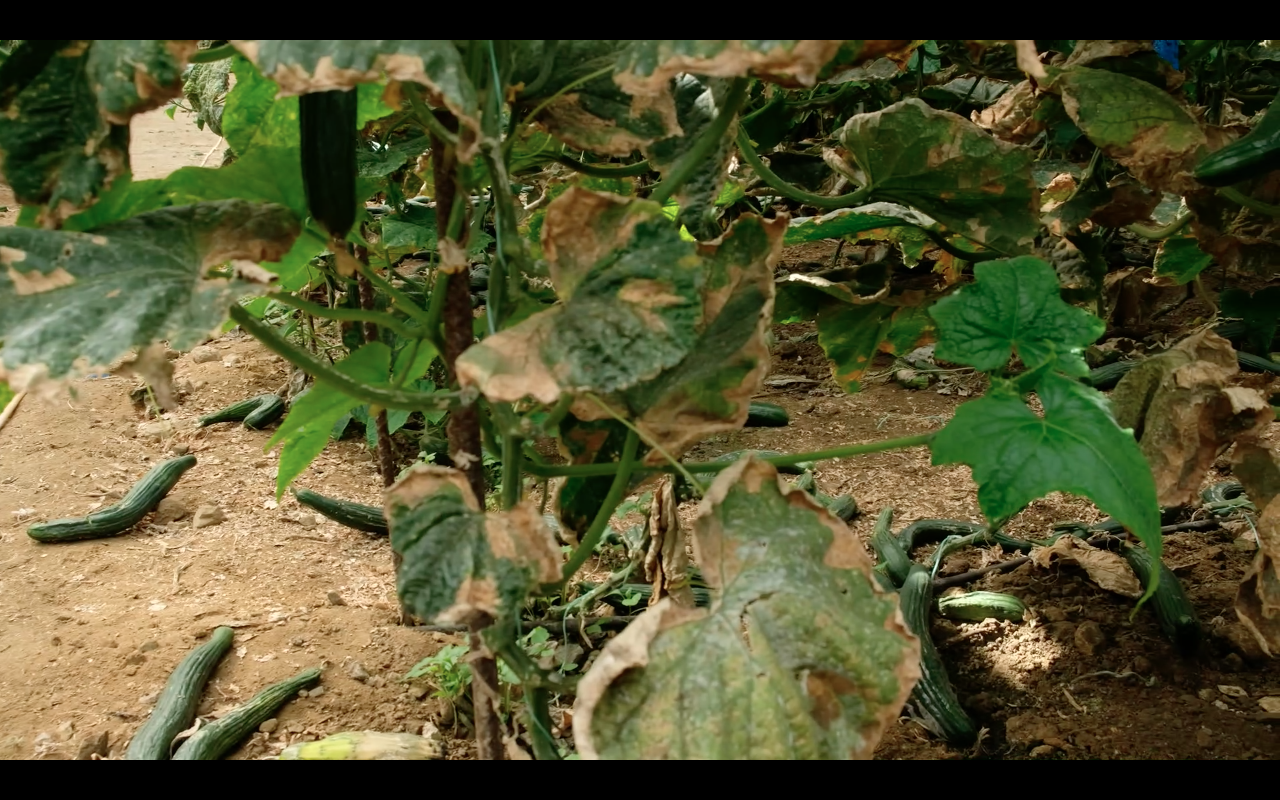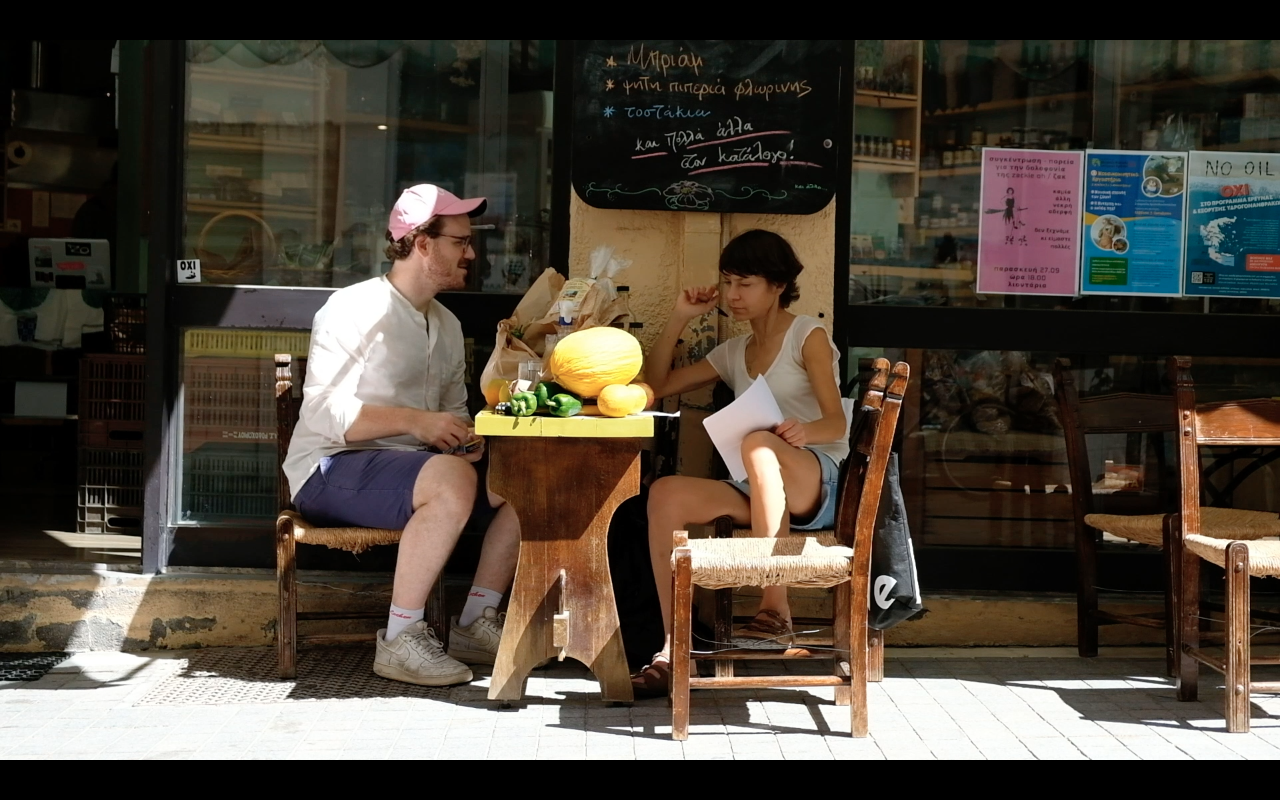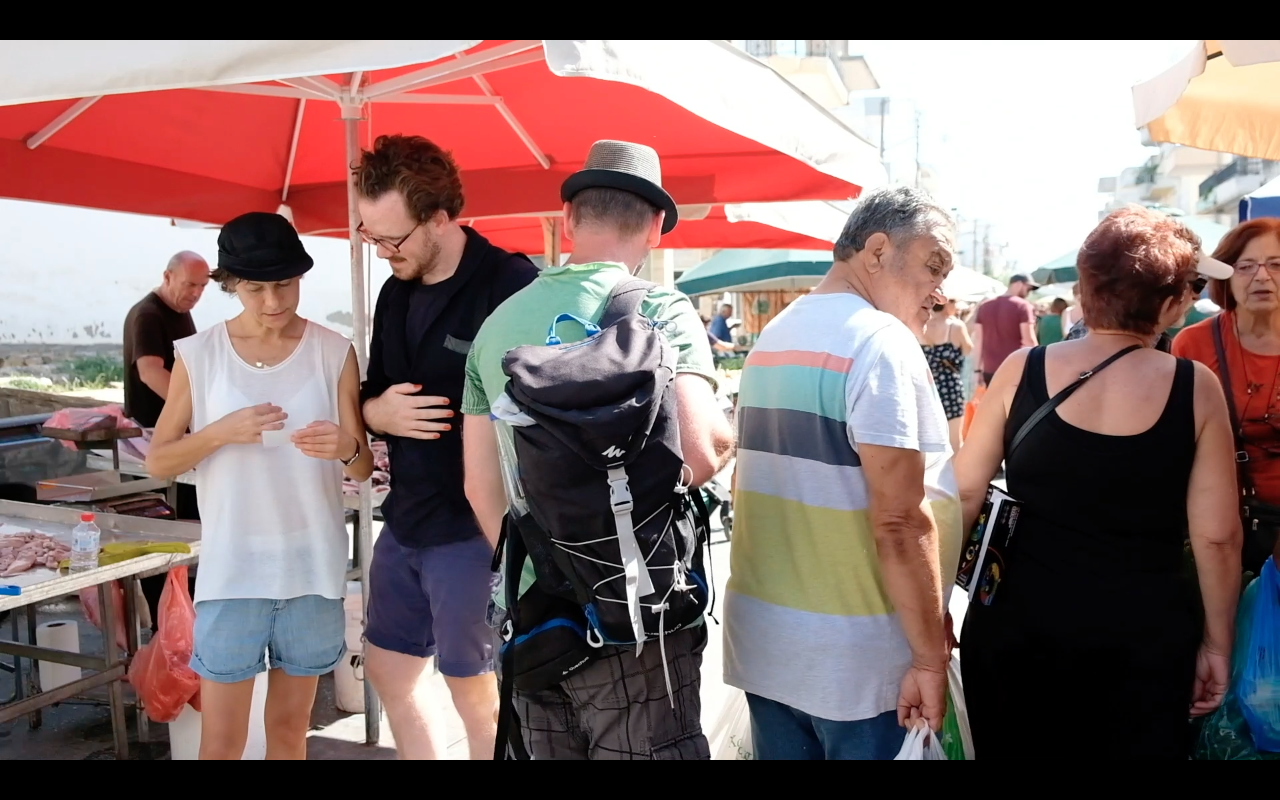Kali Limenes
A small, idyllic place on the Southern coast of Crete. 34º55'51'' North and 24º48'03'' East, according to Google Maps. Seventeen houses, and a small bar covered with palm leaves, right there, on the beach. The water glistens in the sun. It is deeply blue and peaceful. The bay is well protected from the wind and waves, the pebbles and that sand tickle under your feet. Kali Limenes literally means 'good harbors'. Tradition has it that Saint Paul found refuge in this paradise on his way to Rome when his ship was caught in a heavy storm.
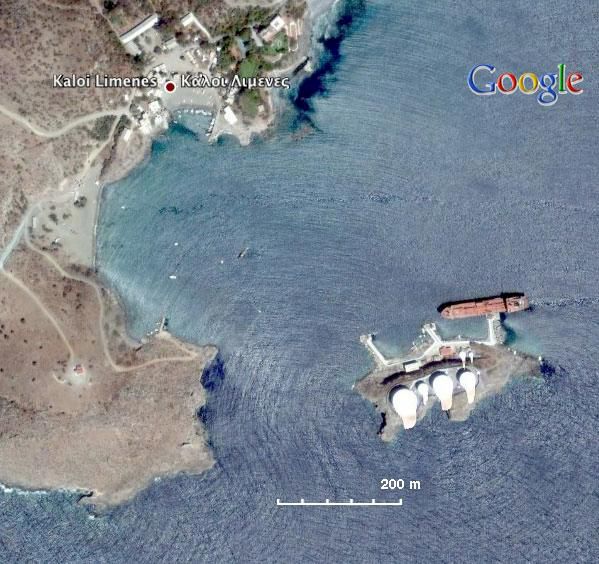


The only thing that disturbs the eye is a large infrastructure facility: In the middle of the bay, on the small island of Mikronisi, there is a bunkering station. Crude oil is being stored in several silos, and used to refuel container vessels, freighters and other boats. The filling station is managed by the SEKA company. The logo of the company, whose double wings remind of Pegasus, is attached to the small seamen's club. In front of it, workers sit in the sun and smoke.

The filmmaker and author Paula Hildebrandt and I spent several days in Kali Limenes in order to get a better understanding of the place. However, our request to visit the bunkering station for artistic research purposes is being rejected by the SEKA several times. Paula thus tries to swim to the island, but does not enter it. Later on, local fishermen take us on a trip around the island for a small fee. One of the fishermen, Minos, who is named after the mythical first king of Crete, tells us about various safety exercises which the SEKA performed just recently, in which oil disasters were simulated. I ask Minos if he has ever been allowed to enter the island. He denies. We have not been able to enter the bunkering station either.
International waters are only a short distance from Kali Limenes. Ships pass this southernmost point of Crete on their way to the Suez Canal, Cyprus, Beirut, Athens or Gibraltar. Since it is cheaper to cross the canal with little draught, some of them fill up their fuel reserves here. Larger ships anchor further out and are loaded by the smaller tankers which lie around the bay like lazy fish.
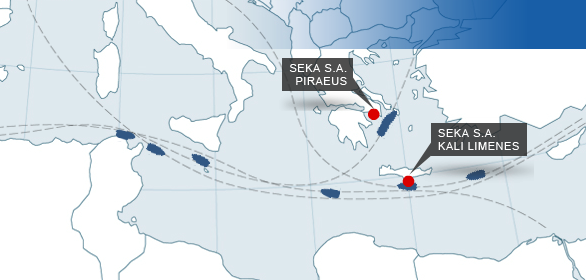
Besides fuel, ships can also order fresh water in Kali Limenes, have the deck cleaned, dispose of their waste, or sign crew members on or off who are not from the Schengen area. Those who wish can also order a selection of Cretan products delivered directly to the ship, including honey, olive oil, oranges, tomatoes, cucumbers and fresh Cretan sea salt. It is then, as if a part of paradise was being loaded.
One wonders whether, for example, the large oil tanks of freighters are also rinsed wihtin the cleaning process, so that small oil particles get to be washed into the seawater. If oil and water meet, paradise might be endangered.
Paula and I do not need to have the ingredients of paradise delivered to our accommodation or car. We simply go for lunch, to the Neo Panorama, in search of a new overview or insight.

Neo Panorama
On the right side of the bay, a few steps lead up the hill. In the tavern called Neo Panorama only SEKA workers sit and eat grilled fish. Except for the bearded men, who give instructions on their walkie-talkies and take a small speedboat trip to the tanker island every now and then, the whole village seems to be deserted. We are the only tourists here, and my impression is that the village is not deserted by coincidence.
After lunch we try to interrogate Alexandra, the waitress of the tavern, about the bunkering station and the slightly run-down hotel on the other side of the bay. It seems to be uninhabited, even if the caretaker family mows the lawn and cleans the swimming pool all year round. Once a year, there is a glittering summer party here, Alexandra reports, with Arab princesses coming over in helicopters. She cannot say much about the bunkering station, though, except that it is guarded by sharks who supposedly circle around the island.
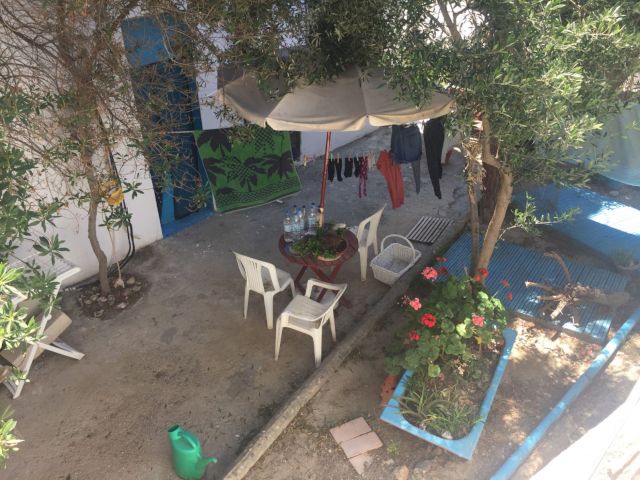
Cf. No. 10 of our Paradise Playlist, i.e. Daft Punk – Loose Youself to Dance
The ingenious inventor Daedalus, the builder of the Cretan labyrinth, once tried to escape the island by flying away, together with his son Icarus. When Icarus came too close to the sun, the wax with which his artificial wings were attached to his body famously melted, so that he fell into the sea and died. At the exact place of his fall is where today, the island of Icaira lies. Fleeing from Minos, the enraged ruler of Crete, Daedalus managed to escape to Sicily, where later he was found. The furious quarrel between the mythical king and his best technologist, who had to murder thy tyrant for self-protection, marks the end of the myth of King Minos.
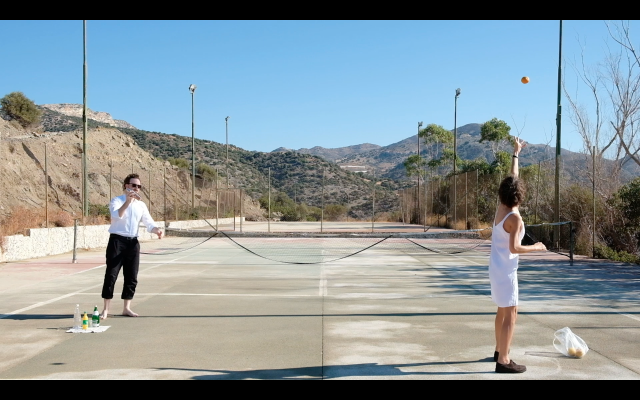
Can you train sharks like you train watchdogs? Do the guests come from Saudi Arabia, or from Lebanon, like the Phoenician princess once called Europe? And do the boys dress up as bulls? In any case, the hotel, just like the bunkering station, belongs to the rich Cretan family that goes by the name of Vardinogiannis.
On the derelict tennis court of the Vardinogiannis hotel, Paula and I play tennis and mix drinks. Rumour has it that the hotel complex used to include a (mini)golf course. More on this later.
The Vardinogiannis
The Vardinogiannis come from a small village named Episkopi in the North-East of Crete. The family is not rich, but maintains good relations with Cretan politicians and the army. It is Nikos Vardinogiannis, the elder brother of the present company patriarch called Vardis, who recognises the strategic importance of the paradisiac bay of Kali Limenes and buys a part of the beach in 1961. Initially, small tankers anchor here to refuel larger ships, mainly those of the Mediterranean fleet of the US Army. For almost no money at all, Nikos also buys the island of Mikronisi from the Greek state. When a tanker accident occurs in 1965, in which large quantities of crude oil leak out, the bunkering station is constructed on the island.
After having returned from our first trip to Crete, with the help of friends, I am able to speak with the Greek activist Ilias Marmaras, who himself comes from a rich family of shipowners. Asked about the Vardinogiannis family, he tells me about a website run by anarchists from Athens and Heraklion. Most of the information referenced here comes from the their website which I translated with the help of Google Translator.

By acquiring the island and the coastal land, the Vardinogiannis have found themselves a little treasure. In order to be able to operate untroubledly, they are driving the local population away. Only a short time later, the illegality of the purchase is pointed out: The land that Nikos Vardinogiannis had originally bought from local shepherds at a ridiculous price actually belongs to the monastery of Ogiditria, which lies above Kali Limenes in the Asterousia Mountains. A theft occurs: unknown persons do not steal the famous icon called 'Zoodochos Pigi', but the land register of the monastery, which is lost ever since.
Zoodochos Pigi, in English: the Life-Giving Spring, is a particular form of depiction of the Virgin Mary common within Byzantine iconography. Mary, who holds her son in her arms, is depicted in a baptismal font. From the basin, like from a fountain bowl, water runs in two (or sometimes four) rivers into a larger basin below. The iconography dates back to a small Marian shrine near Istanbul, the former Constantinople, where now the Church of St. Mary of the Spring stands. In 450 AD, the later Byzantine Emperor Leo I is said to have met a blind man at this excate place, who, having lost his way, asked him for water. Only after an invisible voice tells him about a hidden spring can Leo Marcellus help the beggar. After the blind man has drunk and Leo has washed his eyes, the sight of the beggar is restored miracously. In gratitude, the future emperor erects a church.

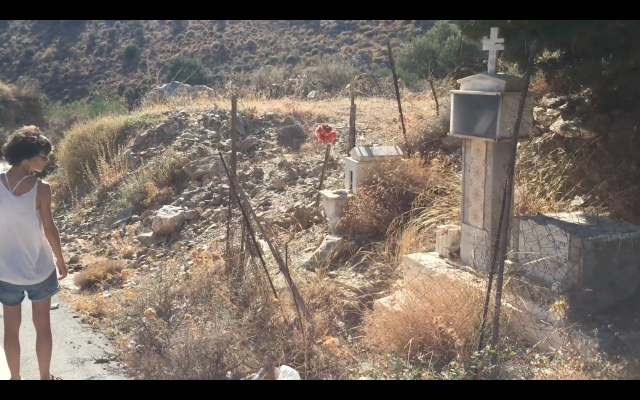

In the following years, there are recurrent disputes with the local population who want to rebuild their abandoned houses in Kali Limenes. When the communist mayor of the neighbouring village of Pigaidakia, in the spring of 1986, decides to visit the patriarch in Istanbul to see a copy of the old land register, he is shot on the road between Pigaidakia and Pómbia on 28 April 1986. The perpetrators will never be caught.
Meanwhile, the Vardinogiannis are expanding their business empire. In autumn 1966, they break the oil embargo against Southern Rhodesia, and in 1971 they buy the refinery in Corinth from the competing oligarch Aristotle Onassis. At the same time, they invest in drilling projects in North Africa and the Arab world. Today, the family owns, among other things, a football club and several television stations, and has holdings in almost 100 companies.
Even if they count the Kennedys and Clintons among their friends, they own estates in London and Athens, and go skiing in St. Moritz, the Vardinogiannis come to Kali Limenes every summer to relax. Can they not get enough of the waves of the Libyan Sea, the Cretan olives and honey? Or is this secluded place their only chance to ever become invisible, to hide from envy, the forces of the market, and the threads of the Moirai? Here, they can bathe naked, and project themselves back in time, to a point before their own fall.
What do you actually want to find out about these oligarchs, Paula asks me. What fascinates you so much about them? Is this your male fantasies of wealth, influence and power? She is right: I am fascinated by their money and connections with which they secretly determine the fate of the island. Besides, not only ships buy fuel from the Vardinogiannis, but also we do ourselves. Through its subsidiary Coral Energy, the family operates all Shell petrol stations in Greece, and, by extension, on the island of Crete. If ever you want to visit the paradise bay of Kali Limenes by rental car, you may have to go shopping at theirs without even knowing it. Paula and I refuel only on the way back. Then we swim at the beach of Kommos.
For ourresearch in Crete, Paula and I have made a playlist that we listen to while driving. It consists of 17 tracks in total. As we find out, our favorite tracks for driving to the beach are No. 6, Gilda – No Me Arrepiento De Este Amor and No. 11, Luis Fonsi ft. Daddy Yankee – Despacito.
Kommos
In contrast to the bay of Kali Limenes, the beautiful, long beach of Kommos is world famous. It lays next to the fertile Messara plain, bordered to the east by the Asterousian Mountains and to the north by the mighty Psiloritis massif, the mythical Mount Ida. In summer, the beach is in the hands of German individual tourists. Since the 70s, Germans have been traveling to the area around Pitsidia, where Paula and I stay. At the beach, they get their coffee and sweets from Kuchen-Uwe (Cake-Baking-Uwe). The German dropout hosts his guests at his ‘base camp’, an old tamarind tree that provides shade and serves as infrastructure. The village of Matala, where in the 1960s young American men moved into Neolithic caves instead of going to the Vietnam War, and were in turn visited by Joni Mitchell and Cat Stevens, among others, is pretty famous, as well.
Paula Hildebrandt has been travelling to Pitsidia every year for more than 30 years. She therefore knows the area in the south of Crete like her pocket. The dossier 'The Logistics of Paradise' is largely based on her preliminary research.
Cf. track No. 12 of our Paradise Playlist, Joni Mitchell – Carey
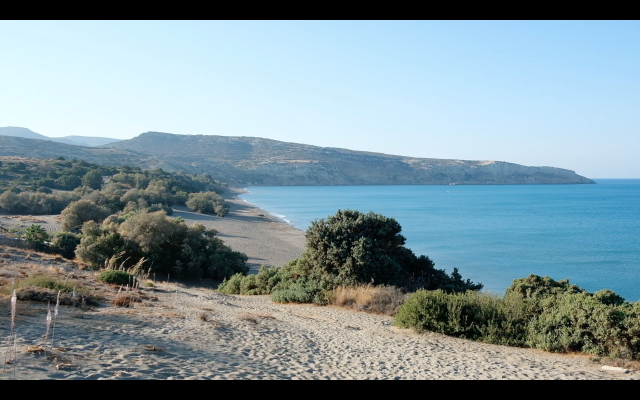
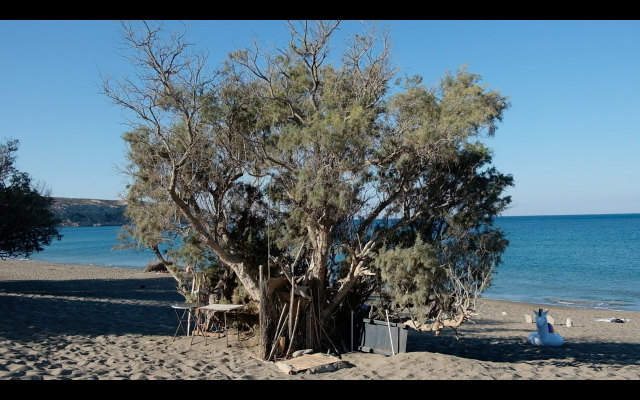
For a long time, it seemed as if the new Chinese Silk Road was to land in Timbaki, at the western end of the bay. Before the Chinese bought parts of the port in Piraeus, there were plans to convert the old military airport of Timbaki into a large container terminal. These plans are on hold for the time being. Recently, large and lucrative oil fields have been found in the waters south of Crete. In 2018, a consortium consisting of ExxonMobil, Total and the Greek company Hellenic Petroleum was granted permission to drill for oil there. Political conflicts between the Greek and Turkish states were to ensue.
Interessanterweise gibt es einige deutschsprachigen Seiten, die gegen das griechisch-chinesische Bauprojekt mobil machen. Während die große Besorgnis um das eigene Urlaubs-Paradies deutlich aus diesen Webseiten spricht, wird immer wieder der Schutz der am Strand von Kommos beheimateten Wasser-Schildkröten als Hauptargument gegen den Bau eines Containerterminals genutzt.
Interestingly, the title of an activist documentary against deep drilling in the Mediterranean, is also titled 'Oil and Water (Don't Mix)'. Paula and me follow the intuition, that is the relation of oil and water that make paradise function, while mixing the two in wrong ways is always a problem.
If you overlook the beach and the Messara plain, you do not immediately see that they are steeped in history. For thousands of years, trade and seafaring have been conducted from here. The people of the Messara plain have always been masters in securing and supplying their paradise by means of extended trade routes. Those who want to know something about it do not drill for oil, but dig deep, into the past.
Excavations
On the beach of Kommos, there is an important Minoan excavation site, which was brought to light by the Canadian archeologists Joseph and Maria Shaw. The old Minoan port of Kommos, which Sir Arthur Evans had already suspected here, supplied the palaces of Phaestos and Hagia Triada more than 3000 years ago. The excavations at Kommos have become famous because of the ship sheds in which the wooden boats of the Minoans were protected both from weather and the salty waters during the winter months.
Joseph Shaw, whom Paula and I also contact, replies very kindly to our emails, and refers to the homepage of his university in Toronto, where many materials concerning the excavations have been digitalized. Above all, Shaw is looking for sponsors who want to develop the excavation site in Kommos into a museum together with him.
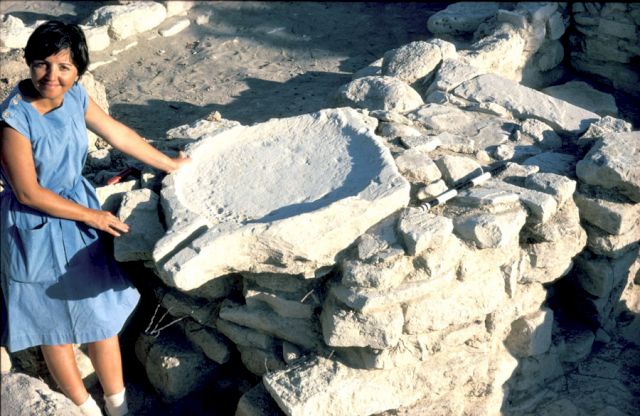

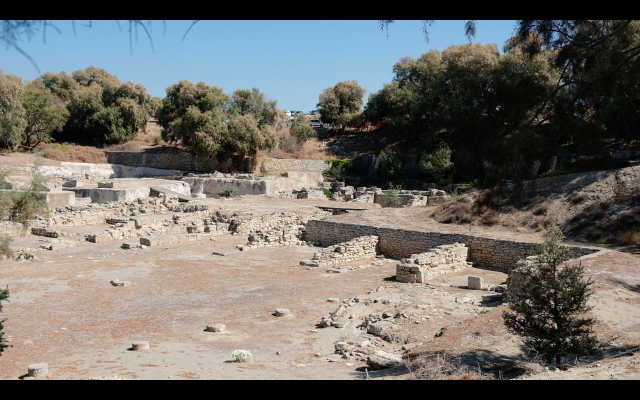
The foundational myth of Europe also dates from this period: On a beach in Lebanon (close to Tyre), Zeus transforms into a bull to kidnap the Phoenician princess of the same name, daughter to King Agenor. He swims to Matala with her, where he transforms into an eagle. Finally, on the mythical mountain (Mount Ida), she bears three children: Minos, Rhadamanthys and Sarpedon, the later kings of the island.
The myth can be read as the expression of a fantasised economic domination of the Minoans over the Mediterranean. They were the first advanced European civilisation to control trade, mainly in the Aegean, between 2500 and 1500 BC. Apart from Cyprus, the Levantine ports of Byblos and Tyros were also ports of call for Minoan ships. Pottery, cloth, wood and metals were traded there. Olive oil (but not yet crude oil) was also an important commodity, already 3000 years ago. The fact that the Greek forefather Zeus abducted the Levantine princess Europe speaks for the already pronounced arrogance and brutality of these early Europeans. At that time, at any rate, the Minoans were inferior to Levantine and Egyptian cities and palaces in terms of maritime trade.
The rule of the Minoans over their own island, on the other hand, is often described as a particularly peaceful period. Motifs such as war or soldiering are not to be found in Minoan depictions; instead, acrobats or flowers reign. It is said that no fortified structures have survived from Minoan times, because they simply did not need them. To researchers, the Minoan civilisation thus appears as a paradise lost–a paradise nonetheless based on local economic supremacy and relative domination of the seas.
At the palace of Phaestos, where the famous Phaestos Disc was found, there are large amphorae that were probably used to store wine and olive oil. The Minoan palaces resembled labyrinths. In addition to the noble chambers, they comprised countless pantries and warehouses, a whole infrastructure for long-distance trade. One of the most important resources for the Minoan paradise was drinking water. Already in the Minoan period, aqueducts led from the water-rich plateaus around the city of Zaros in the direction of the Messara. Still today, tourists drink plastic bottled water from Zaros on the beach of Kommos.
Four thousand years ago, other rules may have applied to paradise. They were, it is speculated, represented on a small round disc of clay, the so-called Pheastos Disc. Researchers assume that the Minoan rules of conduct of the are recorded on the disc, which has not been deciphered until today. On our first trip to Crete we meet the Disc expert Gareth Owens. In ‘real life’ the linguist is Erasmus representative at the Technical University of Heraklion. All the while, he has been researching the Phaestos Disc as a hobby for more than 10 years. Together with his colleague John Coleman, a professor of phonetics at Oxford, Owens claims to at least having deciphered the phonetic sounds of the disc and to be able to translate them to English in parts. The disc, according to him, is a long ode to the female goddess Aphaia, who embodies female fertility and natality. This mother of God, like Astarte, was also worshipped in Egypt, Mesopotamia and by the Phoenician princess Europa. Is there a female power, thus, that precedes male fantasies of dominance over the seas? Owens insists that we listen to a vocal rendering of the disco which he initiated. He also believes that the ode that is written on the disc is similar to Patti Smith's 'Because the Night': I suggest listening to both songs at the same time. This will create an interesting time vortex.
In their book of the same name, the artists Olaf Nicolai and Jan Wenzel interpret the labyrinth as an early, shocking experience of urbanity.
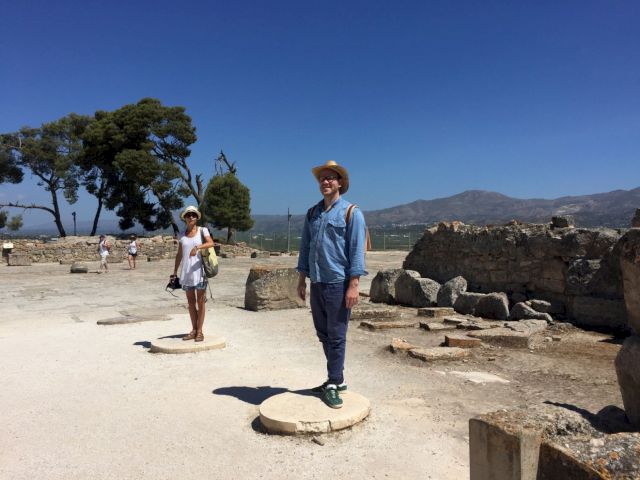
Zaros
At the foot of Mount Ida, in the small town of Zaros, you find the largest mineral water factory of Crete. The water is named after the town itself. In fact, the company still belongs to the municipality itself to a large extent. Water from Zaros is known beyond the island and traded as a delicacy. In 2017, it was declared the best bottled water in the world at the ‘Berkeley Springs International Water Tastings’.

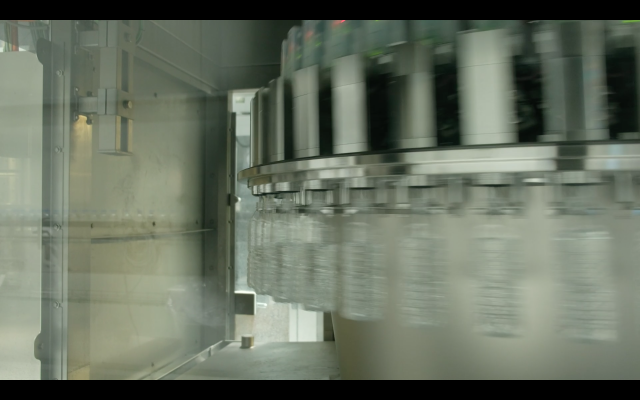
Zaros water is the only certified mineral water on the island and its quality must be tested at regular intervals. Micro-bacterial or viral contamination are to be ruled out. And several times a year the water is savoured by three employees with special training in order to ensure that its taste remains consistent. After all, it is the same water that is bottled in the factory today which was already supplying the Minoan paradise 3000 years ago.
On a guided tour through the factoy, Nikos Spentzouris tells us about these internal water tastings that he has to oversee. Besides gaining an insight into the industrial production of mineral water, Paula and me can stock up on our water supplies. We prefer sparkling water.
In the meantime, water has become a contested resource. Many of the old wells on the Southern coast of Crete have dried up. The natural water cycles are interrupted because of overuse: Whereas, in the past, rain water was collected by the central mountain massif, made its way underground, forming caves and washing out minerals, only to gush out of the ground in various places as a life-giving spring, today, the taps and basins remain empty. Pesticides from intensive agriculture in the Messara plain and old, rusty water pipes also contribute to the fact that in many places the groundwater is no longer drinkable. However, the main reason for the continuing water shortage on Crete is the high water consumption of tourism, especially of tourist infrastructure.
The valley of the philosophers
In the valley of Hersonissos, on the Borth coast of Crete, there exist two paradise places which are characterised by high water consumption: the only 18-hole golf course and the largest water park on the island. These two artificial gardens look at each other with caution and some prejudices:
Nikolaos Sotiropoulos is the General Manager of the Crete Golf Club. He used to be a professional golfer himself and explains the advantages of the luxury sport in detail. One gets to spend time in nature, plays mainly against oneself and not against others, and therefore cultivates concentration, focus and a refined form of self-awareness. The perfect swing, which has to be practised for years, is almost a mythical thing: It is not about hitting the ball, says Sotiropoulos, the ball simply finds itself at the right point within the swinging motion. It is in the way, so to speak, and thus flies far and beautifully. The Crete Golf Club, he assures us, is self-sufficient in terms of water supply. Water is collected in a pond, kept fresh by a large fountain, and distributed over the entire course with a complicated system of pumps. The only environmental costs occur because of the operation of the pumps.
We meet Nikos Sotiropolous twice for a coffee in his golf club. During our first conversation, the elegantly dressed man tells us about his interest in philosophy. Among other things he points to the ancient Greek roots of the word logistics. In ancient Greek, the word logistike referred to the practical art of calculating.
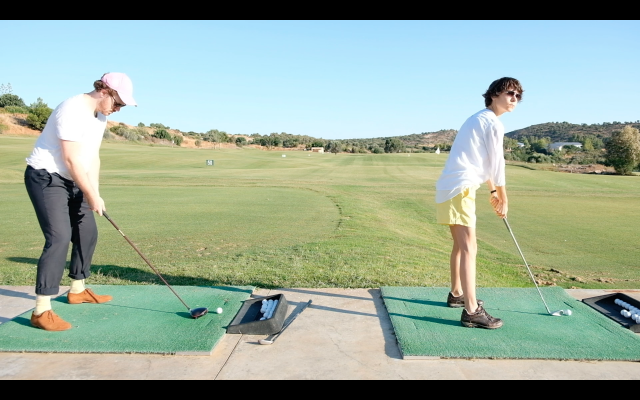
Xenophon Ritsopoulos, Chief Executive Officer of acqua plus Waterpark on the other side of the valley, raves about the liberating energy of the slides. Whoever comes to the water park is ready to leave their worries behind. Exuberance, he assures us, requires an appropriate attitude, which all of his consumers muster. Here, the focus is not on a refined self-relation, but on tangible bio-chemical processes of pleasure, namely vertigo and acceleration. The water for the park is provided by a private well, says Ritsopoulos. In a gigantic sewage plant underneath the park, the used water is purified. At least some of it can thus be returned to the slides or used to irrigate the overflowing flowerbeds and shrubs. Water is only lost through evaporation, says Ritsopoulos.
In addition to his role as manager of the water park, Xenophon Ritsopoulos also runs a start-up called ‘WePlayHappy’, which produces toys for therapeutic use. He seems to be an expert on paradise. Indeed, when we tell him that we are researching the logistics of paradise, he replies: "You think you can capture paradise in pictures or words? No, you have to experience paradise!"
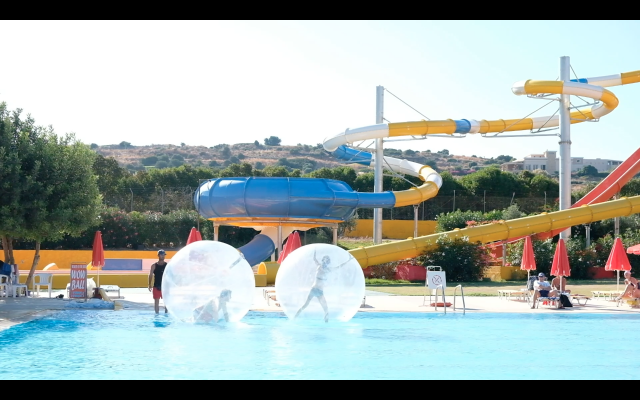
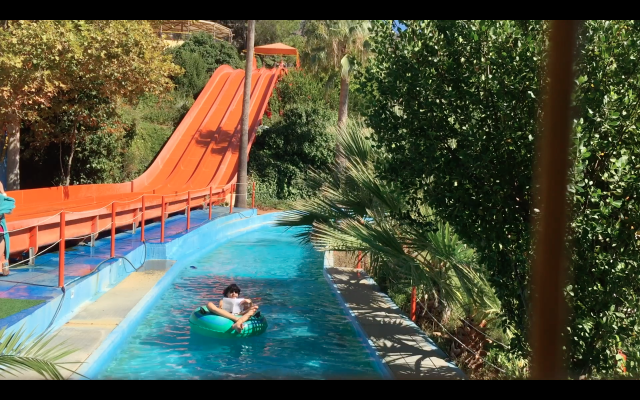
Here, two forms of shaping nature and resources for the purpose of enjoyment and self-experience face each other. While Nikos can be considered more of a Stoic, Xenophon can easily be assigned to the Epicureans. Their respective gardens of pleasure could not be more different: although both places are complex, artificial landscapes with high water consumption, their unequal philosophies become evident in their design. In one case, it is a matter of moderation, elegance and visual balance, in the other, of exuberance, joy and bright colours. In Hersonissos, for once, we get to choose for ourselves which of the two paradises suits us more.
Cf. Track No. 12 of Paradise Playlist, Tori Amos – Smells Like Teen Spirit
Paradise as garden
Time and again, people have imagined the paradise as a garden, including the Garden of Eden from the bible. In fact, the term goes back to a number of historical gardens, the so-called pairidaeza. Its Persian name is made up of the words pari (around) and daeza (wall) and describes gardens that were surrounded by walls, protecting the flowers and shade inside. These gardens were often artificially irrigated. Indeed, it was the elaborate handling of water (partly by means of aqueducts) in the ancient Persian Empire that may have impressed Xenophon, the Greek student of Socrates, who described these gardens for the first time.
The wall of the garden signifies both protection and exclusion. Not everyone is allowed in, or–as in the case of the golf club and the water park–one has to pay admission. The etymology of the word thus points to the artificial aspects of paradise: It is a designed landscape with water infrastructure, the carelessness that it affords is a manufactured cultural experience. An adapted formulation of this equation which could account for contemporary tourism might then read as follows: You are in paradise as long as the tank of your rental car is filled, your supply of drinking water is steady, and someone else is making your bed. Your own carelessness is always based on steady supplies, and all too often it is dependent on the care work of others. Supply chains and care work are part of the logistics of paradise. The question remains: Who pays the price of paradise? And: how can it be obtained or transported?
Essences and perfumes
But what if paradise was not a real or imagined place, but rather a fleeting experience, as Paula says, whose components cannot be defined? For some, the glitter of the sea is as much part of it as is the scent of the hills. One place where such scents are collected and preserved is the herbal distilleries.
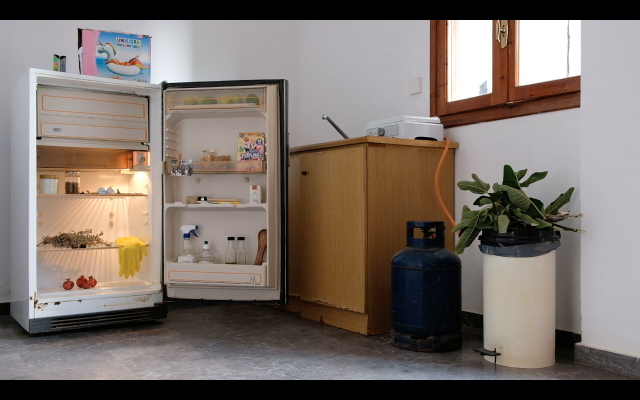
The Kurtes distillery is run by Nikos Doulgerakis and, like the noble water, it is located in Zaros. Doulgerakis produces aromatic oils from wild herbs, ranging from sage to eucalyptus. There are two ways to produce scented oils and perfumes: water-based and oil-based methods of essence extraction. In Zaros, large quantities of herbs are steam-boiled. The steam is collected and condensed so that the liquid fragrance essence (in the form of oil) can be separated from the condensed water. In the olfactory preservation of paradise, oil and water have to collaborate, once again. In Kurtes, you can also buy homemade olive oil and dried herbs, but no salt.
Much of what Paula and I have found out about the entanglements on the island of Crete is based on the stories and narratives of the people we have met. The web of their stories is interwoven with the rumours and fabulations of the island itself - the famous Cretan kutsobolio. Nikos Doulgerakis, the owner of the distillery in Zaros, for example, tells us about fake herbs that are shipped from North Africa to Crete and then sold as real Cretan herbs. He tells us about his time in the army, and that to keep his business with olive oil, essences and herbs afloat is much harder a fight than he ever fought during his military times. Now, he says, the enemy is in his back. At the dam in Faneromeni, which secures the water supply for the Messara plain, we meet the German engineer Walter Hochstein, who supervised the construction work here a few years ago. He shows us the small leakage in the dam where water is constantly leaking out. It is used to irrigate the olive groves of the farmers in the valley without them having to pay for it. The Vardinogiannis family was described to us by Yannis Giannoutsos, who runs a well-known herb shop as Mr. Botano in Kouses. Other informants not yet mentioned by name are Dr. Alexandra Rassidakis, Elena Vasnaki, and Paula's hosts Nikos and Maria.
In order to obtain our own part of paradise, Paula later introduces me to the natural salterns on the beach of Kommos. They are small pools in which sea water evaporates over time. When you climb inside, you can simply scrape the sea salt with a spoon and put it into a plastic bag.

Container (and cucumbers)
Because paradise is always based on material surrogates, it needs containers that provide its ingredients with a little shelf life. It is amphorae, baskets and glass tubes in which the oil, the scents and the salt of the earth can be stored. The goods that supply the holiday paradise on the Southern coast of Crete, on the other hand, are delivered in shipping containers to the port of Heraklion and transported to the Messara plain by truck, on the newly built motorway. On the opposite lane, tomatoes and cucumbers wrapped in plastic, which are cultivated for the European market based on excessive use of strong pesticides, leave paradise.

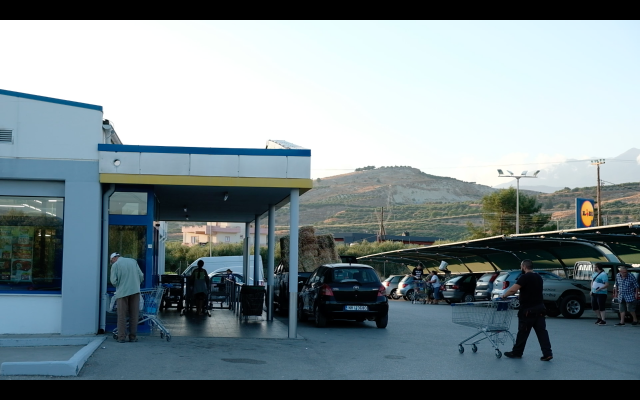
It is in Kali Limenes, one could speculate, where the container ships that transport these goods to and from Crete will be refuelled. And the tankers that transport the diesel that we fill into tank of our car must also refuel somewhere. In the process, the oligarchs become richer and the water gets scarcer. In order to ensure the supply of more and more tourists, carelessness is gradually being lost.
This problematic logic of continuous growth and scalability is perhaps best symbolized in the empty greenhouses along the entire southern coast of Crete, not far from Kali Limenes. A few years ago, cucumbers were still being grown here for the European market. The area itself is therefore called the Cucumber Coast. Today, nobody takes care of the plants any more. Perhaps, cultivation is no longer profitable. Capital has moved on.

The cucumbers keep on growing without anybody harvesting them. Like dead snakes, they lie around on the floor of the grandiose, heated greenhouse, announcing the improbable prospective end of capitalism. Who knows, maybe one day they will wake up and offer us a second apple, which might lead back to paradise. For the time being, the cucumbers celebrate a mourning ritual directed towards the future, unseen and unheard of, only accompanied by the warm wind that tugs at the plastic walls of the greenhouse.
Moirologists
Throughout Greece, but also in Crete, so called moirologists used to be employed as professional mourners for funerals. The profession of these women, which generates a form of female anger and force beyond male power struggles, is almost extinct today. In their practice, the patriarchal power of logistics is countered by other, invisible forces: those of conjuring ghosts and the dead, but also of cursing the living.
Cf. also Track No. 17 of Paradise Playlist, Nina Simone – Stars

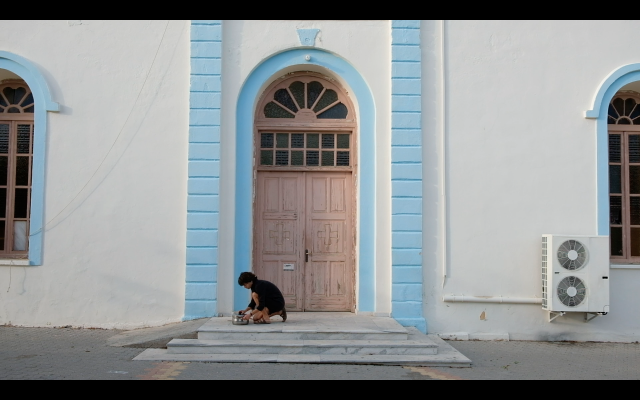
The notion of moirologist is derived from the Greek words moira (fate) and logos (word). Moirologists are those who make fate by mourning our losses. They thus continue the work of the Moirai. In Greek mythology, like the Roman Parcae, the Moirai are a group of three goddesses who weave the web of life, thereby determining destiny. Even the gods, even Zeus, cannot change the fate woven by the Moirai.
In a shop in Pitsidia, near Kommos and Kali Limenes, there is a photography, hanging just next to one of the refrigerators, that depicts the Moirai. They hold their spindles as if it was weapons, but smile peacefully. They do not care much about the sell-out of water and oil, the swimming pools, golf courses and luxury hotels. They weave a net that lies beneath the exploitation of land and people and will, one day, hold those that profit without paying responsible. The Moirai, shown in the photo, are also the great-grandparents of the shopkeeper.
Nobody know, how paradise works. Perhaps the women in the picture in Nikos' shop in Pitsidia remind us that a logic (and logistics) of efficiency will not be able to maintain it. It requires different ways of dealing with the land and other forms of relationship.
Olive oil and biodiesel
The anarchist BeCollective produces olive oil. It is part of the Integral Cooperative of Heraklion, which has established its own local currency for the exchange of goods and services. Their currency is called Kouki, like the fava beans that were used as an early form of currency in Crete. It is intended to function as a means of exchange, so that the collectives and individuals involved in the Integral Collective can fulfill their basic needs through direct exchange. The BeCollective's Cretan oil–in contrast to the crude oil of the Vardinogiannis–will not become part of a global (luxury) economy. It can only be bought, at least in Hamburg, from a solidarity economy cooperative.
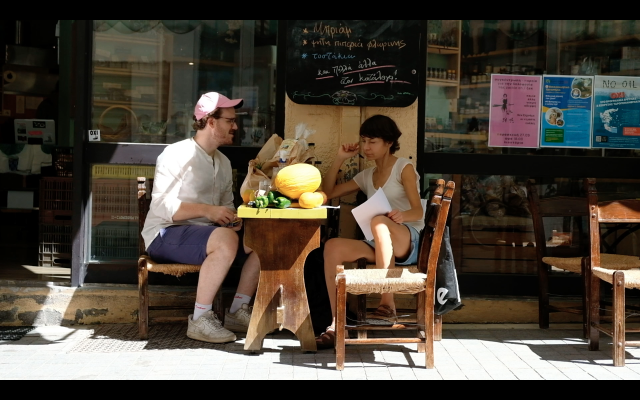
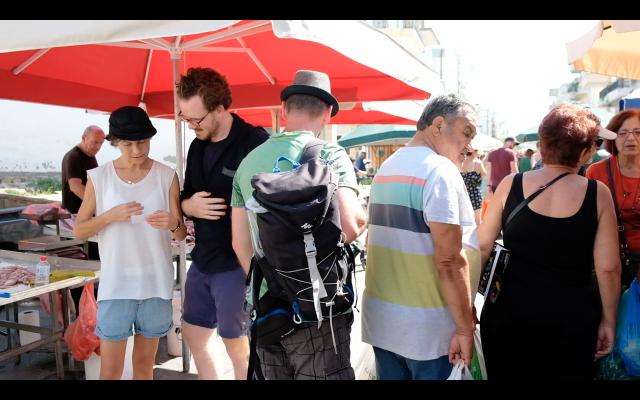
In Heraklion, the activist Michalis tells us about the possibility of producing organic diesel from recycled deep-frying oil. The cooperative is interested in using the industrial process on a small scale to cover its own fuel needs. The machine has already been purchased, the only thing missing is methanol, which is not available in Greece. With that material in hand, the old oil could be turned into new diesel and in turn power the machines that would harvest the olives. It would be a kind of modular refinery.
I can imagine how one day the bunkering station in Kali Limenes would be used to sell recycled organic diesel. The hotel would then no longer be an exclusive summer residence, the sharks would be released, and you could camp on the tennis court again. But would there really be enough organic diesel to supply all the tourists with Zaros water in plastic bottles? And would we, once we were allowed to enter, have to stay in paradise forever?
On one of our evenings, my flatmate Hans from Pitsidia, tells me the following story: 30 years ago, on his very first trip to Crete, he claims, they camped on the tennis court of the Vardinogiannis family in Kali Limenes. At the time, he claims, the hotel used to own a (mini-)golf course, too. This came in handy, for his girlfriend would use the holes as makeshift toilets.
At the foot of Mount Ida, in the small town of Zaros, you find the largest mineral water factory of Crete. The water is named after the town itself. In fact, the company still belongs to the municipality itself to a large extent. Water from Zaros is known beyond the island and traded as a delicacy. In 2017, it was declared the best bottled water in the world at the ‘Berkeley Springs International Water Tastings’.
